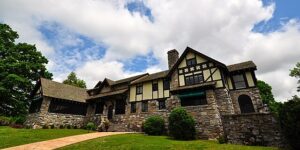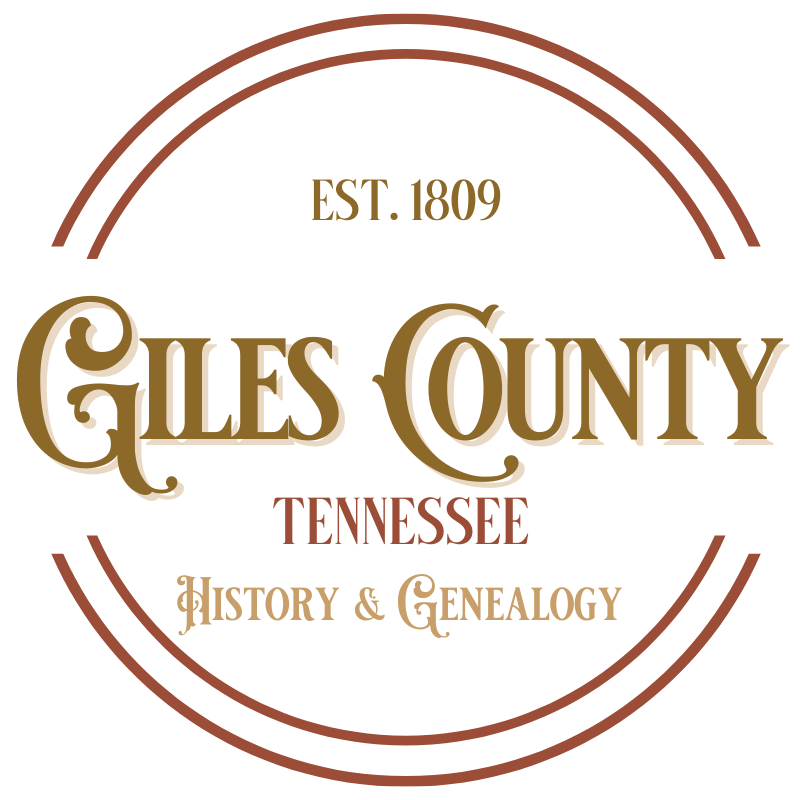Community Histories of Giles County, Tennessee, 1941 – 1942
Campbellsville
Campbellsville is a lovely community located in the north-central section of Giles County. As to all Giles Countians, naturally, Giles County is the best county in Tennessee—so with the people of Campbellsville, Campbellsville is the best community in Giles County. The woodlands full of wildlife, the rolling hills, the fertile valleys, the beautiful lakes and streams abounding with fish—these and many other things make a distinct impression on even the mere passerby.
As far as we have record, the Indians were the first inhabitants of this community. At that time, what is now Campbellsville was only a canebrake. All records and other available information show that Crockett Campbell and his family were the first white people to settle here. In 1817, Campbell erected a big log house, which still remains standing. Remodeled, it is the present home of Mr. and Mrs. Kirk Carden.
Many interesting tales have been handed down to us about the actual presence of bears and other animals unknown to these sections of the country as we know them today. Mr. Campbell, to whom we have referred, had actual experiences with bears. He noticed that every day his dogs would go to a certain spot in the canebrake, and so one evening, deciding to follow them, he found the bears drinking at a nearby spring. This within itself was an explanation for the dogs’ barking. This same spring is known as the Campbellsville Spring today and still supplies water to the people of the community.
Mr. Campbell gave land for the public square, and as other families moved into the community, the name of Campbellsville was bestowed upon it in honor of Mr. Campbell. A post office was established, and the mail was brought to and from Pulaski only about once a week. Today, to us, this is almost unbelievable, as we have mail coming in on four different routes daily.
Religion has always held a high place in our community. The first church services that were held in Campbellsville were conducted under a bush arbor on a spot called the campgrounds. Now it is known as the Campbellsville Cemetery. First churches were crude log buildings, the first of which stood where the present Cumberland Presbyterian Church now stands. In our community today, several religious denominations are represented, all active in their own churches, which consist of the Methodist, the Presbyterians, and the Christians. The young people of the community manifest an unusual interest in the League and other Christian organizations.
Next to religion in the line of importance came the schools. As in most cases in rural communities, the early school facilities were inferior to our present setup. The buildings were log, without the comforts and conveniences that we know today. The school sessions were short, with very scant equipment. School transportation was unknown, and many hardships were endured by both the teachers and the students. “Reading, Writing, and Arithmetic were taught to the tune of a Hickory stick.” One teacher served the entire community.
As in any progressive community, the interest in education became widespread. Two- and three-teacher schools replaced the early one-teacher schools. Our present school came into the picture in 1924. The building, which is brick in structure, is desirably located in the heart of the community. Seventeen years ago, when the present building came into existence, the faculty consisted of five teachers. The student body increased, thus demanding annexes to the building and an addition to the teaching force.
Today, the faculty consists of eleven teachers, headed by the principal T. A. Passons and ably assisted by efficient County officials, including our County Board of Education, Supervisor, and Superintendent, of which we are justly proud. The present student body is made up of about 350 pupils. Modern buses serve as a means of transportation for many of these pupils. Athletics plays an important role in the school activities. We boast of good football and basketball teams, both elementary and high school. Clean sportsmanship is stressed throughout. We consider our hot lunch program a big asset to our school. Various organizations, the Parent Teachers Association, Athletic Association, 4-H Clubs, Commercial Club, Home Economics Clubs, Class Organizations, and other wide-awake groups, keep enthusiasm high at all times, making the school system, in its entirety, an overwhelming success.
A keen sense of patriotism, love and respect for our country has always been evident throughout the community. This within itself is enough to swell any loyal American’s heart with pride. It is a pleasure to know that Campbellsville has always furnished more than her quota of soldiers in every war dating from the Civil War on. What more can a man give than to lay down his life to his country? It is with a feeling of both pride and sorrow that we recall the names of Jim, John, and David Rittenberry, P. H. Yokley, R. N. Campbell, George Gibson, Willie C. Hayes, and Kirby Cheatham, who gave their lives for the sake of democracy.
Farming is the leading occupation of the community. Livestock, however, has a place of its own. Rich mineral deposits are found in sections of the community—the most important of which is phosphate. Great quantities of this important mineral are mined in the Wales Station section. Campbellsville has always been a thriving little community. It has blacksmith shops, grist mills, cotton gins, garages, and sawmills. The soil is highly productive—cotton, corn, tobacco, sorghum, peanuts, watermelons, hay, and vegetables are grown.
We are proud of the efforts the people of this community have thrown into life’s balance. Men and women have gone out in every walk of life—doctors, lawyers, teachers, preachers, prosperous businessmen, and well-rounded citizens. Even in the world of invention, Campbellsville has not been left out. Mr. A. E. Wright invented a corn planter which has become famous as the Wright Bros. Corn Planter. Mr. Grady Collins invented a machine to measure cloth. This instrument has been so successful that it is now used in all department stores. We are justly proud of the contributions our community has made in the past, and with this foundation, it is still a progressive community making contributions daily.
Politics is important in the development of any country, so it has been important in the development of our community. As far back as 1809, we find Jacob Baylor and John Dickey appointed magistrates by the Legislature. John Dickey served as Representative in the Legislature in 1817. Other representatives this community has furnished are Sam Yokley, J. C. Hannah, and Clarence Campbell. Mr. Hannah served as a member of the County Court for many years, later becoming Judge, in which capacity he served until his death. Upon his death, his son, Campbell Hannah, succeeded his father.
Our community has furnished many other county officers, some of whom are Mr. Polk English, Sheriff; Mr. J. C. Abernathy, Trustee; Mr. R. J. Hannah, Tax Assessor; and Mr. Herbert Evans, Register. Today, we are represented in the County Court by the efficient Mr. Campbell English and Mr. Eugene Brown.
Our community has within its scope one of the most outstanding show farms of the entire Southland—this being no other than our beautiful Milky Way Farms. Milky Way Farms owes its origin to Mr. F. C. Mars, wealthy candy magnate of Chicago, Illinois. Having been so fascinated by the beauty of this community before acquiring his enormous wealth, Mr. Mars, after making his million, set out to secure for his own some of this land. The farm consists of 2,700 acres, beautifully landscaped. He became interested in show cattle and racehorses and had his farm well stocked with one of the best shorthorn herds in the United States. Doubtless, the clubhouse is one of the most elaborate buildings in Giles County. Today, the clubhouse is the home of Mr. Mars’ own daughter, Patsy Mars Feeney.
 In 1934, death claimed as its victim Mr. Mars. It was his request that upon his death, he be buried on the farm that he loved so well. In keeping with his wishes, his remains were laid to rest on the summit of a high hill overlooking the farm. Here, a beautiful mausoleum has been erected in his memory. The farm has attracted universal attention. Visitors representing all parts of the United States, as well as foreign countries, have acclaimed the beauty of the farm. The farm today is not operated on as large a scale as it was during Mr. Mars’ lifetime. Mrs. Mars is deeply interested in racehorses. In 1940, one of her many fine horses, Gallahadion, won the Kentucky Derby. The farm is still well kept, affording employment for many of our local people. The farm is under the present management of Mr. Michael Allen Feeney, Mrs. Mars’ son-in-law.
In 1934, death claimed as its victim Mr. Mars. It was his request that upon his death, he be buried on the farm that he loved so well. In keeping with his wishes, his remains were laid to rest on the summit of a high hill overlooking the farm. Here, a beautiful mausoleum has been erected in his memory. The farm has attracted universal attention. Visitors representing all parts of the United States, as well as foreign countries, have acclaimed the beauty of the farm. The farm today is not operated on as large a scale as it was during Mr. Mars’ lifetime. Mrs. Mars is deeply interested in racehorses. In 1940, one of her many fine horses, Gallahadion, won the Kentucky Derby. The farm is still well kept, affording employment for many of our local people. The farm is under the present management of Mr. Michael Allen Feeney, Mrs. Mars’ son-in-law.
Needless to say, Campbellsville has many undeveloped possibilities. Outstanding among these is Marcella Falls, located a few miles from the center of Campbellsville. At one time, the city of Pulaski considered piping water to supply the town from these falls.
Our attempt to write the history of Campbellsville has been meek in view of the fact that nothing we could say would do justice to the history of this splendid community. We are proud of our community, our village, our school, and our homes.
We know of no words more fitting in concluding this history than those of Robert Foster in his little booklet entitled What Campbellsville Has Contributed to the World:
“If you want men, high-minded men, who value honor and truth above life itself, we have them. If you want women who are loyal and true, pure-hearted and kind, we have them. If you want boys who are eager for life’s battle of right against wrong, ready to join in the fray, we have them. If you want girls with white souls kept free from stain, who will someday be queens in future homes, we have them. We are ready at all times to give ourselves wholeheartedly to any noble enterprise.”
Source:
Note: Each community history was prepared by the elementary students and teachers of that particular community as a part of the work for the Giles County Association for Childhood Education. A county-wide exhibit of each community in miniature was displayed at Pulaski during American Education Week

Miss Alma Rittenberry, a native of Campbellsville, originated the idea of building and naming highways for our country’s leaders. She went to Washington and submitted her plan, thus giving an idea that has become famous throughout the world. Below is the Bureau of Public Roads & American Association of State Highway, Nov. 11, 1926, after the United States System of Highways was adopted for uniform marking by the American Association of State Highway Officials.
